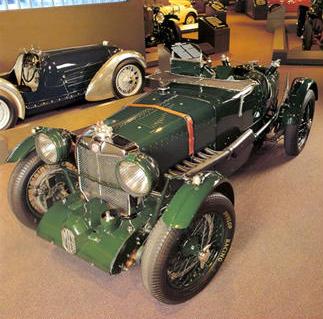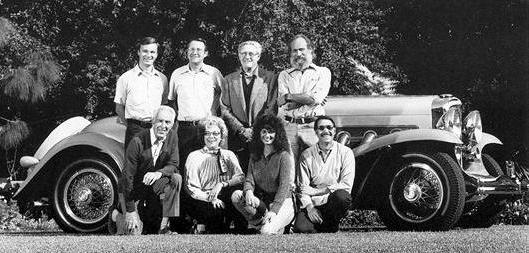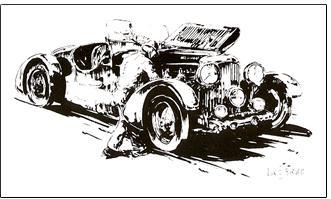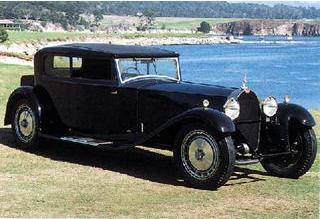Text by Kane Rogers

1933 MG K3 Magnette was one of the best pre-war
cars in the Cunningham Museum collection.
Briggs disbanded Team Cunningham after the 1963 Le Mans 24 Hours. Some team members went on to continued racing success; some retired to quieter lives. Briggs, who was not quite done behind the wheel, would race again at Sebring; in 1964 he joined New Jersey Porsche dealer Lake Underwood to drive a new factory-backed 904, finishing ninth overall and first in the under-2-litre prototype class. Then, after purchasing the car, Briggs teamed with old friend John Fitch for the ’65 race, which they failed to finish. Afterwards, at the age of fifty-eight, Briggs finally decided to retire from racing.
Briggs had kept almost all of the significant cars he had owned over the years – a fact that was common knowledge amongst his friends, many of whom had toured the collection at Greens Farms with Briggs as their guide.
After quitting racing in Europe in 1963, Briggs married Laura Cramer Elmer and moved his household to California, where Laura had grown up. Then, using his own transporter and a trailer provided by his friend Bill Harrah, he moved the entire collection of cars from Greens Farms to a Costa Mesa warehouse. Word spread, and visitors soon started showing up to see the cars, which were barely viewable in their cramped surroundings.
The new Mrs. Cunningham, a product of California’s car culture, began poring over the books in Briggs’ extensive library in order to learn more about the treasures gathered in the warehouse. She soon came to believe that the collection needed a proper home, one that would welcome the public. Briggs agreed: “The museum came into being because I needed something to replace the racing,” he said.

Museum Staff. Front row, left to right: John Burgess, Joyce Cox, Chrystal Anastasia, Gene Sherman.
Back row, left to right: Art Van de Water, Richie Van de Water, Briggs Cunningham, Don Edmondson.
Car: 1935 Duesenberg short-wheelbase SJ roadster.
The Cunninghams first considered a location in Anaheim as, in 1965, there was still acreage available near Disneyland. In a decision they later came to regret (Laura and Briggs both saw in hindsight that proximity to the park would have helped attendance at the museum), they opted instead for a parcel of land owned by the Irvine Corporation, the largest landholder in Orange County. After some legal wrangling that saw the deal go from two-and-a-half acres to five, a 40,000 square-foot concrete building was erected. A store and offices were partitioned in the front of the building and maintenance and restoration shops located at the rear, leaving 30,000 sq. ft. for the display area.
The schedule for delivering the cars to the museum was nearly disrupted when a rare deluge hit the area, washing out the still-unpaved parking lot. Friends in the right places came to the museum’s assistance in the form of a rescue mission mounted by the U.S. Marine Air Corps, which laid sections of perforated landing strips to facilitate the movement of vehicles over the mud and into the building.
The Briggs Cunningham Automotive Museum opened with a black-tie gala affair for 650 invited guests on February 5, 1966. The proceeds benefitted the South Coast Child Guidance Clinic. Guests dined on Salad d’endive-Sebring, Chateaubriand-Le Mans, Pâte de tamale-Spa, Courgettes a la rembourrage-Monza, Petit pain-Montlhéry, Cerises jubilé-Watkins Glen, and café-Mille Miglia, after which they danced to the music of Stan Kenton’s Band.
The Museum was very much a labor of love for Briggs, as it came to be for the many people whose passion for cars somehow led them to contribute their time and skills to the dream. Briggs first hired Chuck Stanley, an old-school mechanic and machinist who graced the collection with his craftsmanship for twenty years.

From the Museum Preview Catalog, a drawing
by John Burgess of Briggs’ 1933 4.35-litre Bentley.
Dick Ford, a USAF mechanic from Edwards AFB, had just retired when he visited Briggs with a reference from Road&Track‘s Dean Batchelor, becoming the Museum’s second employee. It took Dick several tries before he was able to convince his friend and former Edwards co-worker John Burgess to pay a visit to the warehouse. (The Museum building was still in the planning stages.) Burgess met with Briggs and, joining him for a tour, realized that he had seen many of the cars during his days in New England. In fact, he had worked on more than a few of them in his own shop, including the 1927 Grand Prix Delage raced at the New York World’s Fair twenty-six years earlier by Hugh Bancroft. The two found an instant rapport, and for years worked closely on the direction of the Museum. That these two men, who had met briefly during the 1940 World’s Fair, should come together again to share the purpose of preserving this marvelous collection seemed no less than preordained.

The Kellner-bodied Bugatti Royale
in majestic repose at Pebble Beach
Joyce Cox, who knew nothing about automobiles when she was hired as secretary, dove in to her duties right away, asking John Burgess to recommend a list of books from the Cunningham library. It was not long before Joyce was sufficiently knowledgeable about the Museum to be able to conduct tours as well as handling secretarial work and holding down the storefront, which she did for twenty-two years.
Laura Cunningham was the dynamo. She worked as the Museum’s secretary-treasurer but also in many other capacities, from researcher to government liaison to legal advocate, always defending the standing and reputation of their beloved undertaking. Stories abound of Laura’s battles with local and state authorities trying to impose arcane regulations or grab taxes, most such tales ending with said authorities exiting with their tails between their legs. The few times the state was able to dig into someone’s pockets were cases in which cars loaned to the collection were taxed as unlicensed race cars. Sometimes the owner wrote a cheque to the California treasury in order to allow the car in question to remain at the Museum; other times the object of the levy simply disappeared across the line to Harrah’s in Las Vegas.
Such endeavors not only consumed the Cunninghams’ time, but huge amounts of cashflow as well. The Museum’s income over the years never did match its expenses, and finally Briggs and Laura decided to sell one of his prized possessions, the Kellner-bodied Bugatti Royale, reasoning that its sale would keep the Museum going at least for the rest of Briggs’ days. As it happened, a friend of the Cunninghams had been encouraging Miles Collier to purchase some of the Museum’s collection, and Collier flew to California to discuss the matter with Briggs and Laura. At first, Collier was interested in only the Cunningham cars and the Ferrari 166 in which his uncle Sam had been killed at Watkins Glen. By the time he left to return to Florida, he had purchased the entire collection.
It was not an easy thing for Briggs to see his collection go to another owner, but he was pleased that it would be transferred to the stewardship of the Collier family. Collier’s father, C. Miles, and uncles Sam and Barron, Jr., had been close friends of Briggs and indeed had gotten him started in sports car racing all those years ago.
Website Disclaimer
Please read the disclaimer prior to entering this website. You may access it by clicking here.